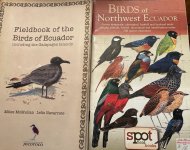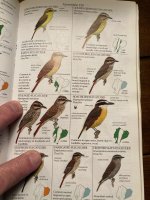For a recent trip to Ecuador, I used Freile and Restall as well as McMullen and Navarette (2nd ed). I found the little "fieldbook" very handy for quick reference, although obviously out of date on many matters. Freile's text is excellent, and I really wish he had gotten into the Lynx FieldGuides series and had their illustrations (Restall's are accurate but mostly look like old skins in a museum drawer). McMullen's plates on wading birds and raptors are very good and a bit leisurely, while his plates for most passerines look out of focus, hurried, and and often have muddy colors. The more generous treatment in the first half is offset by crowding in the second half, where I really wanted the detail. We don't go to Ecuador for terns but tanagers. I would trade a slightly bulkier volume for sharper treatment of passerines. Otherwise, really concise information and useful field tips.
In any case, by chance I ran into Navarette in Quito and asked him if a 3rd edition was coming, and he said yes, in either late 2023 or 2024, and that they were working on improving the plates. He emphasized that they wanted it to work for birders, but that they also had a limited production budget.









